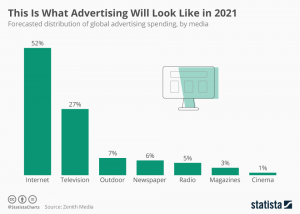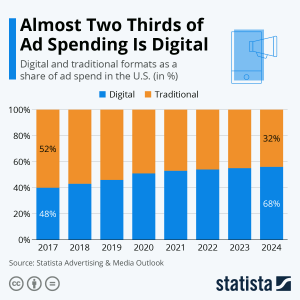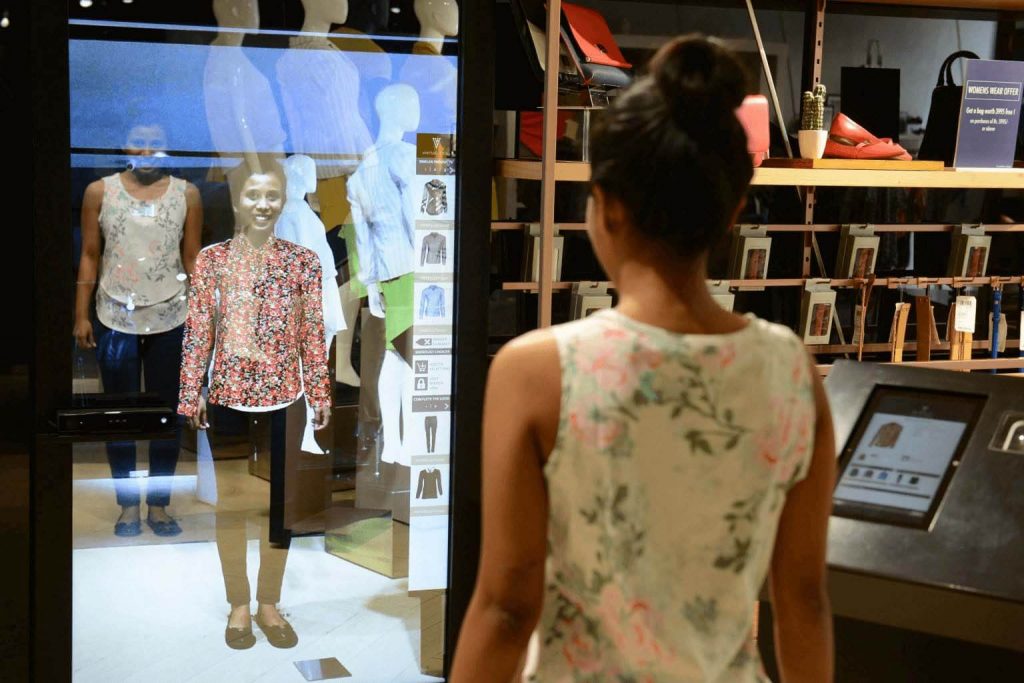It’s time to address the future of a new digitalized reality. As we continue to see more businesses adding new digital layers to their marketing campaigns, it’s clear that the future of advertising is truly a technological phenomenon waiting to happen.
From the rise in social media platforms such as TikTok and Instagram replacing TV celebrities with online ‘opinion leaders’ to the vast technological developments that are driving the future of online marketing, it’s time to take a step back from traditional advertising forms and embrace a modern-day marketing strategy build on dynamically digital ads.
How Has The Advertising Industry Changed?
For the vast majority of the last century, advertising has dominated the television industry, allowing advertisers to convey their voice through the medium of broadcast to a mass audience. From creative storytelling to time-centric celebrities, this form of advertising was once the go-to for any brand that was determined to make an impact.

(Source: Statista)
However, as popular streaming services such as Netflix and Amazon Prime have hit the scene, gone are the days of watching advertisements between episodes, it’s time to welcome the ‘skipping’ generation instead.
In fact, studies have shown that since 2010, over 86% of the population have reported skipping advertisements during prime time television, posing as an issue for popular brands that once relied on a broadcast medium for their marketing campaigns.
It’s time to accept that the future of advertising is online. With over 4.5 billion active internet users globally, the audience for marketers has quickly shifted. As brands now fight to connect with digitally native demographics, the digital high street has begun to boom.
 (Source: Statista)
(Source: Statista)
The problem is, consumers are now in charge of the material that they consume and how they want to consume it. With the audience now leading the advertisers, the model for the perfect marketing campaign has quickly shifted. Marketers need to get creative. Gone are the days of traditional copywriting, hooking this generation of consumers is predicted to be much harder.
With the market for digital advertising expected to grow to £517 billion by 2023, new trends are hitting the scene to keep brands fresh and in tune with an ever-changing audience. From the rise of the online influencer to immersive tech arrivals such as AR and VR, it’s time to assess how this new form of advertising will transform the industry, and create digitally dynamic Ads as we’ve never seen before
The Rise Of Augmented Advertising
As the development of technology continues to change the way we as an audience communicate and interact with each other, it’s no surprise that the advertising world has picked up on new technological trends for future campaigns.
Online advertising simply isn’t enough in 2021. YouTube advertisements and Instagram pop-ups have dominated advertising for the past decade, but new technology is here to play, providing users with the most immersive advertising experience yet.
Augmented advertising is here to stay. As an immersive form of technology, that allows consumers to physically interact with the advert in front of them, brand leaders have realized that this form of marketing could transform ad revenue.
What Is Augmented Reality?
Augmented Reality is a new form of immersive technology that allows consumers to combine both reality and the virtual world. Using digital layering, AR developers are able to create a digitally enhanced experience that an audience can interact with and visualize as if it were part of the world around them.
Using motion sensors, clever layering, and AI, consumers can see a newly digitalized version of their surroundings, placing animation onto real objects, or labeling their surroundings with information enhancing content.
This may sound like the beginning of a dystopian movie, but you’d be surprised to know that AR is not new to the digital scene. In fact, many of us have experienced its brilliance without even knowing. The average smartphone can now use AR to project interactive Snapchat lenses, immersive apps such as Pokemon Go, and even enhance your online shopping experience, allowing app users to digitally try on clothes without leaving the comfort of their home.
 (Source: Statista)
(Source: Statista)
AR has been hidden in plain sight, however, it’s now time for it to take center stage. As a now vital part of a number of industries ranging from the public sector to video entertainment and consumer-based advertising, smart marketers are using it to their advantage. As AR developers continue to manufacture smarter technology, immersive wearables, and innovative applications to continually make the consumer experience easier, AR/VR technology is predicted to be the future of the advertising industry.
How Will AR Change The Advertising Industry?
Augmented Reality is set to revolutionize the advertising industry for a number of reasons. From providing a deeper form of connection between the brand and the consumer, to the smart money-saving marketing techniques this technology will make possible, AR is set to boost sales for both large brands and small start-ups, making it a business owner’s dream.
As technology continues to change the way consumers interact with both each other and the content we see on our screens, marketers will need to get creative in order to battle competing brands. However, whether you’re looking to add some modern-day digital charm into your next advertising campaign or a consumer reading up on the smart marketing practices of the future, fear not, we have you covered.
Here are some of the ways we think AR advertising is going to shift the dynamics of the advertising industry and how you can insert the strategies into your own digital campaigns.
Immersive Advertising
 (Source: Getty Images)
(Source: Getty Images)
Immersive advertising is the key to high audience engagement. Creating an advertisement that audience members can physically interact with builds an emotional connection that images and banners cannot compete with. AR Ads are created to be interactive and lifelike, providing the consumer with that little bit extra.
For example, imagine you’re walking past a billboard for a high street brand. You see models wearing the clothes you’ve been dreaming of and you wonder what they could look like on you. Enter AR, your interactive advertising assistant. Using the magic of AR technology, consumers are able to simply point their smartphone cameras at the advertisement and view the clothing in real-time, possibly even on their own bodies. The potential of this clever marketing technique is endless, but interactivity is most definitely the way forward.
Interaction doesn’t only hold consumer attention for longer but creates an emotional connection that will encourage customers to make a purchase. Thanks to the diverse range of possibilities AR presents for immersive advertising, generating emotional connections with the viewer will not only sell products but also sell a brand reputation, keeping the customers coming back for more.
Saving Marketers Money
Traditional advertising may have a successful reputation, but that reputation can come with a cost. On average, a TV advert at peak times can cost anything from £3,000 to £10,000 and print ads can be just as pricey.
Alternatively, Augmented Reality can be a powerful investment for advertisers looking to increase their revenue. Simple AR can cost marketers money, but it’s worth the investment if you want to increase engagement. Better still, marker-based AR simply uses an image marker such as a banner or a magazine image before transforming it into an AR-focused campaign that is designed to stick. While a 30-second advertisement on television is over as soon as it starts, AR-generated advertisements have longevity and can be watched time and time again.
Better still, location-based AR avoids printing ads altogether, instead of focusing on your GPS location. This not only saves marketers money but encourages the consumer to check out their brand in the area.
Also read: How to Make Strong PPC Advertising For Campaign
Boost Sales For Small Businesses
Modern-day advertising is all about analyzing behavior and targeting adverts appropriately in order to see the best success rate. Small businesses rely on this as they often have a niche, more selective demographics on their journey up to the top of their game.
AR aids small and local businesses and boosts sales, thanks to its ability to enhance advanced hyperlocal advertising. Unlike traditional hyperlocal strategies that target locals through print and local broadcast, AR infused hyperlocal ad does more than simply advertise a cafe or local outlet, but target customers who show interest and physically guide them to their destination.
This only enhances the advertising experience for small business owners but attracts a larger pool of customers to their business.
Has Covid-19 Boosted AR’s Potential?
The question is, have the effects of the pandemic pushed advertising into Augmented Reality’s favor? The answer is yes. As high street shops continue to fall in the wake of the pandemic, the digital high street has never been busier.
As a larger audience turns to technology in the wake of lockdown, Augmented Reality has never been so in demand for large business corporations. Whether it’s the retail sector or the real estate sector, it’s clear that AR is continuing to have an impact on the future of advertising.
Download those smartphone apps, watch out for interactive billboards, and most importantly be excited for a new wave of creative marketing strategy that is about to transform dynamic advertising as we once knew it.










Leave a comment